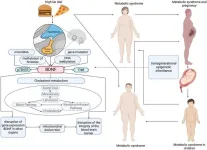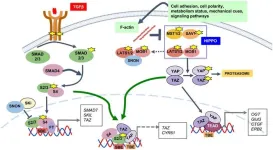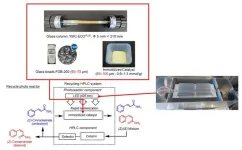(Press-News.org)
Metabolic syndrome (MetS) is a multifaceted disorder that impacts approximately 20–25% of the global population. This syndrome encompasses a range of conditions, including obesity, type 2 diabetes mellitus, hyperinsulinemia, insulin resistance (IR), hypercholesterolemia, nonalcoholic fatty liver disease, nonalcoholic steatohepatitis, and systemic metabolic inflammation. These conditions collectively lead to severe diseases and increased premature mortality. The hypothalamus, a critical brain structure regulating eating behavior, plays a pivotal role in the development of MetS. The connection between psychoneurotic disorders and MetS underscores the significant role of the brain in the syndrome's progression. Additionally, MetS is associated with cancer development, likely mediated by hypothalamic dysfunction.
The hypothalamus is integral to energy homeostasis and metabolism regulation. Inflammation and alterations in hypothalamic function can precipitate MetS. In animal studies, a high-fat diet (HFD) in mothers results in hypothalamic inflammation and gliosis in offspring, contributing to metabolic dysregulation. The blood-brain barrier (BBB) integrity is compromised, allowing inflammatory mediators and fatty acids to affect fetal hypothalamus development. These alterations lead to changes in neuronal communication, increased expression of inflammatory markers, and disruptions in insulin and leptin signaling pathways, promoting obesity and insulin resistance in offspring.
Maternal and paternal obesity can epigenetically reprogram offspring, affecting their metabolic health. Maternal HFD exposure leads to significant changes in the hypothalamus of the offspring, including increased expression of genes associated with inflammation and altered neuronal signaling. These changes are sex-specific, with female offspring exhibiting greater susceptibility to metabolic disorders. Paternal obesity similarly influences offspring through epigenetic modifications, such as hypomethylation of growth-regulating genes, contributing to metabolic dysfunctions.
The maternal hypercaloric diet affects lipid metabolism and the endogenous cannabinoid system in the hypothalamus of adult offspring, leading to sex-specific metabolic responses. This diet induces an increase in the expression of lipid metabolism-related genes and cannabinoid receptors in the hypothalamus. Such changes disrupt normal metabolic processes, contributing to the development of obesity and other metabolic disorders in offspring.
Developmental programming plays a crucial role in determining the susceptibility to metabolic disorders. During critical periods of development, exposure to adverse environmental factors, such as a hypercaloric diet, can permanently alter hypothalamic structure and function. These changes predispose individuals to metabolic disorders later in life. Epigenetic mechanisms, including DNA methylation and histone modifications, mediate these long-lasting effects. For example, miRNAs are crucial in regulating hypothalamic development and function, with their expression being influenced by maternal diet.
The hypothalamus contains several key signaling pathways that regulate energy balance and metabolism. The Notch signaling pathway, for instance, is involved in hypothalamic neurogenesis and is disrupted in the offspring of obese mothers, leading to altered neuronal development and metabolic dysfunction. Similarly, the POMC neurons in the hypothalamus, which play a critical role in regulating appetite and energy expenditure, are affected by maternal obesity and hyperglycemia, resulting in increased food intake and weight gain in offspring.
Metabolic syndrome's complexity is underscored by the intricate interplay between genetic, epigenetic, and environmental factors. The hypothalamus's central role in regulating metabolism and the significant impact of parental obesity on offspring's metabolic health highlight the importance of addressing these factors to mitigate the rising prevalence of MetS. Understanding the epigenetic and developmental mechanisms involved provides insights into potential therapeutic targets for preventing and managing metabolic disorders.
Full text
https://www.xiahepublishing.com/1555-3884/GE-2023-00202
The study was recently published in the Gene Expression.
Gene Expression (GE) is an open-access journal. It was launched in 1991 by Chicago Medical School Press, and transferred to Cognizant Communication Corporation in 1994. From August 2022, GE is published by Xia & He Publishing Inc.
GE publishes peer-reviewed and high-quality original articles, reviews, editorials, commentaries, and opinions on its primary research topics including cell biology, molecular biology, genes, and genetics, especially on the cellular and molecular mechanisms of human diseases.
GE has been indexed in Medline (1991-2021), Scopus, Biological Abstracts, Biosis Previews, ProQuest, etc.
Follow us on X: @xiahepublishing
Follow us on LinkedIn: Xia & He Publishing Inc.
END
SAN ANTONIO — July 30, 2024 — Dr. James Oxley, an Institute scientist at Southwest Research Institute’s Chemistry and Chemical Engineering Division, has been named a Fellow by the Controlled Release Society. Recognized for excellence and innovation in delivery science, Oxley is an expert in microencapsulation, nanoencapsulation and other controlled-release technologies used in energy, food, pharmaceutical, cosmetic and consumer product applications.
“I’m honored and humbled by this recognition,” said Oxley, who began his Institute career in 2004. “Encapsulation research ...
University of Virginia School of Medicine researchers have identified a potential treatment for the respiratory symptoms of long COVID after discovering an unknown cause of the condition inside the lungs.
The UVA researchers, led by Jie Sun, PhD, found that COVID-19 infection can cause sweeping changes in immune cells inside the lung tissues, promoting scarring and driving ongoing inflammation even after the initial infection has passed. This ongoing inflammation, they believe, drives the lasting respiratory symptoms, such as cough and difficulty breathing, associated with long COVID.
The new research from Sun and ...
BEER-SHEVA, Israel, July 30, 2024 – Antibiotic resistant bacterial pathogens are on the rise, while fewer antibiotics are being developed. Prof. Ariel Kushmaro and his local and international colleagues tackled the need by focusing on the long pepper. Known in traditional medicine for its treatment of a variety of illnesses, the team created a derivative that disrupts bacterial chemical communication.
Their findings were just published in Biofilm (https://doi.org/10.1016/j.bioflm.2024.100215).
Many plants' secondary metabolites are essential ...
By Benjamin Boettner
(BOSTON) — Since the 1950s, researchers have used a famous method invented by Wallace Coulter known as “flow cytometry” to characterize different types of immune cells in research studies and in blood samples from human individuals. This has enabled a much deeper understanding of immune cell development as well as new ways to assess human health and diagnose various blood cancers. Later, flow cytometry was applied also to other cell types.
In traditional flow cytometry, cell surface and intracellular proteins are detected with antibody molecules that are linked to fluorescent probes. However, while providing single-cell ...
Not all police misconduct is the same. Misconduct can range from offenses like homicide and sexual assault to seemingly minor infractions such as accepting free coffee from the public. Exactly what qualifies as police misconduct varies locally, and the response to this behavior is typically handled internally by law enforcement.
The absence of a commonly accepted framework to assess and interpret police misconduct remains a complex and contentious issue. Moreover, progress in researching this area is hindered by the limited ...
Genetically engineered human skin bacteria can make mice less attractive to mosquitoes for 11 days. Mosquitoes transmit a host of deadly diseases, including malaria, West Nile, dengue, yellow fever, and Zika. Female mosquitoes on the hunt for a blood meal tune into scents released by skin microbes that live on their targets. Omar Akbari and colleagues engineered versions of the common human skin commensals Staphylococcus epidermidis and Corynebacterium amycolatum to produce much less of a form of lactic acid known to attract mosquitoes. The authors tested the microbes alone and found the engineered version of S. epidermidis attracted about half as ...
The liver's ability to communicate with other organs is crucial for maintaining homeostasis, particularly through signaling pathways. During liver regeneration, communication with organs such as the brain, pancreas, intestine, and heart is vital, mediated by chemical messengers like hormones, cytokines, and growth factors. Among these signals, the TGF-β and HIPPO pathways are critical, functioning as tumor suppressors and regulating liver development and regeneration. The review focuses on these pathways' interplay in maintaining liver homeostasis, facilitating regeneration, and contributing to diseases like hepatitis, fibrosis, ...
A study explores the microbiome of keloids, which are treatment-resistant raised scars. Some wounds heal completely; some wounds leave a scar; and some wounds leave a noticeable raised and growing bump larger than the original wound called a keloid. These keloids can itch and cause psychological distress. Keloids are caused by hyperproliferation of cells called fibroblasts that produce collagen. Previous research had suggested that microbiota might be one of many factors influencing fibroblast production. Rui Chen, Tomasz Maj and colleagues looked for bacteria in clinical samples of keloid tissue and found higher concentrations ...
Cancer is a complex, multifactorial disease with a substantial global burden. Recent years have seen a surge in research focusing on preventive measures, particularly through diet and supplements. The role of nutrition in cancer incidence and prevention is widely recognized, though the specifics of these relationships remain under investigation. This review expands on the findings of Anandu Chandra Khanashyam et al., exploring the nuanced links between diet, supplements, and cancer prevention.
The significance of diet and supplements in cancer prevention is well-documented, with nutrition ...
Z-alkenes are organic compounds with a double bond between two carbon atoms and two substituents attached to the carbon atoms on the same side of the double bond. They are ubiquitous structural components of organic compounds in chemistry and biology. It is well known that many of the Z-alkenes cannot be prepared through conventional methods involving thermodynamic methods while photoisomerization can offer good yields. Photoisomerization is a process in which the structural arrangement of an isomer of a molecule is changed to another isomer by absorption of light. The photoisomerization of E-alkenes to produce Z-alkenes ...






